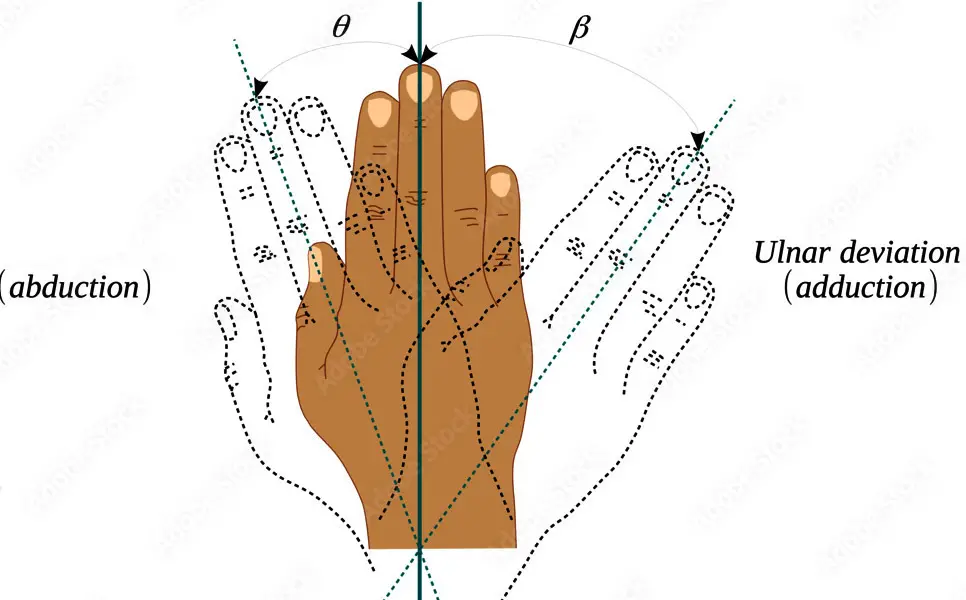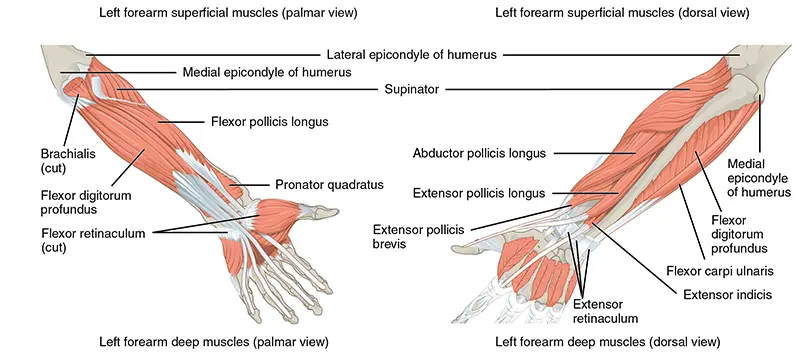Forearm Muscles used in Piano Playing
The muscles situated in the forearm regulate the movements of the hand and some of those of the fingers. They fall into four general classes;
- flexors and extensors of the wrist;
- flexors and extensors of the fingers;
- pronators and supinators of the forearm;
- abductors and adductors of the wrist.
- the flexors and extensors of the hand (carpus) and
- those of thumb and fingers.
On account of the form of the wrist-joint, why are "flexion and adduction" more extensive movements than "extension and abduction?
The wrist joint, also known as the radiocarpal joint, is a condyloid joint. This type of joint allows movement in two planes:
In summary: The combined effect of bony structure, ligamentous support, and muscular arrangement allows for a greater range of motion in flexion and adduction compared to extension and abduction at the wrist joint.
- Sagittal plane: Flexion (bending the wrist downward) and extension (bending the wrist upward).
- Frontal plane: Adduction (bending the wrist towards the pinky side) and abduction (bending the wrist towards the thumb side).
- Bony Structure: The shape of the bones forming the wrist joint inherently favors flexion and adduction. The distal end of the radius (forearm bone) has a larger articular surface on the palmar side (towards the palm), allowing for greater movement in flexion. Similarly, the arrangement of carpal bones (wrist bones) facilitates a wider range of motion in adduction.
- Ligamentous Support: The ligaments around the wrist joint are stronger and more taut on the dorsal side (back of the hand) than on the palmar side. This restricts extension and abduction to a certain degree, while allowing more freedom of movement in flexion and adduction.
- Muscular Arrangement: The muscles responsible for flexion and adduction are generally stronger and more numerous than those responsible for extension and abduction. This disparity in muscle power contributes to the greater range of motion in flexion and adduction.
In summary: The combined effect of bony structure, ligamentous support, and muscular arrangement allows for a greater range of motion in flexion and adduction compared to extension and abduction at the wrist joint.
First form versus Fingers Extended
Note:
If the wrist is flexed or extended with the hand in a fist-form, the movement will be less than when the fingers are extended also.
This illustrates the summation of the action of the two sets of muscles.
The extensors of the fingers aid the flexors to bend the hand forward.
If the wrist is flexed or extended with the hand in a fist-form, the movement will be less than when the fingers are extended.
The extensors of the fingers aid the flexors to bend the hand forward.
The wrist-joint bends more readily backward than forward, a remnant of the time when the fore-limbs were still used for locomotion.
The greater range of lateral wrist motion toward the fifth-finger side of the hand is the result of skeletal structure, the ulnar bone being shorter than the radius.
Wrist abduction and adduction
Wrist abduction and adduction depend upon the extensor-flexor position of the wrist. When the wrist is bent back (dorsally flexed) abduction and adduction at the wrist are impossible and are replaced by pronation and supination of the forearm. With the hand out of line with the forearm, we cannot turn the hand sidewise without rotating the forearm in the radio-ulnar joint. Lateral wrist motion is only possible when the hand is normally extended. Lateral wrist motion is possible when the flexors and extensors are in a state of equilibrium. The purpose of movement is to enable a part of the body to reach a desired point. The same point may be reached by the fingers either through wrist extension plus abduction or through wrist-flexion and forearm supination. The muscles of supination are much stronger than those of pronation. Although a movement may objectively appear the exact reverse of a given movement, it does not follow that the two are exact physiological opposites. One movement may involve greater muscular effort than the other. An example of this is the difference between the power of supinating and pronating.

It is more noticeable here in flexion than in extension.

The greater range of lateral wrist motion toward the fifth-finger side of the hand is the result, not so much of muscular action, as of skeletal structure, the ulnar bone being shorter than the radius.
Wrist abduction and adduction, moreover, depend upon the extensor-flexor position of the wrist.
When the wrist is bent back it is dorsally flexed. When the wrist is bent back, abduction and adduction at the wrist are impossible and are replaced by supination and pronation of the fore-arm, so that with the hand out of line with the fore-arm we cannot turn the hand sidewise without rotating the fore-arm in the radio-ulnar joint. Lateral wrist motion, accordingly, is possible only with the wrist normally extended, that is to say, when the flexors and extensors of the wrist are in a state of equilibrium.
All this is natural, since the object of movement is to enable a part of the body to reach a desired point and the same point may be reached by the fingers either through wrist extension plus abduction, or through wrist -flex ion and fore-arm supination. Nature is not concerned particularly with the means, so long as the goal is reached.
All this is natural, since the object of movement is to enable a part of the body to reach a desired point and the same point may be reached by the fingers either through wrist extension plus abduction, or through wrist -flex ion and fore-arm supination. Nature is not concerned particularly with the means, so long as the goal is reached.
Muscles of Supination
The muscles of supination are much stronger than those of pronation, a difference utilized in the direction (to the right) in which a screw-driver is turned. Although a movement may objectively appear the exact reverse of a given movement it does not follow that the two are exact physiological opposites. One often involves greater muscular effort than the other.
A conspicuous example of this is the difference between the power of supinating and that of pronating, just mentioned.